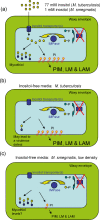Strategies for acquiring the phospholipid metabolite inositol in pathogenic bacteria, fungi and protozoa: making it and taking it
- PMID: 19383710
- PMCID: PMC2889408
- DOI: 10.1099/mic.0.025718-0
Strategies for acquiring the phospholipid metabolite inositol in pathogenic bacteria, fungi and protozoa: making it and taking it
Abstract
myo-Inositol (inositol) is an essential nutrient that is used for building phosphatidylinositol and its derivatives in eukaryotes and even in some eubacteria such as the mycobacteria. As a consequence, fungal, protozoan and mycobacterial pathogens must be able to acquire inositol in order to proliferate and cause infection in their hosts. There are two primary mechanisms for acquiring inositol. One is to synthesize inositol from glucose 6-phosphate using two sequentially acting enzymes: inositol-3-phosphate synthase (Ino1p) converts glucose 6-phosphate to inositol 3-phosphate, and then inositol monophosphatase (IMPase) dephosphorylates inositol 3-phosphate to generate inositol. The other mechanism is to import inositol from the environment via inositol transporters. Inositol is readily abundant in the bloodstream of mammalian hosts, providing a source from which many pathogens could potentially import inositol. However, despite this abundance of inositol in the host, some pathogens such as the bacterium Mycobacterium tuberculosis and the protist parasite Trypanosoma brucei must be able to make inositol de novo in order to cause disease (M. tuberculosis) or even grow (T. brucei). Other pathogens such as the fungus Candida albicans are equally adept at causing disease by importing inositol or by making it de novo. The role of inositol acquisition in the biology and pathogenesis of the parasite Leishmania and the fungus Cryptococcus are being explored as well. The specific strategies used by these pathogens to acquire inositol while in the host are discussed in relation to each pathogen's unique metabolic requirements.
Figures



Similar articles
-
The role of iron in protozoan and fungal infectious diseases.J Eukaryot Microbiol. 1999 May-Jun;46(3):231-8. doi: 10.1111/j.1550-7408.1999.tb05119.x. J Eukaryot Microbiol. 1999. PMID: 10377984 Review.
-
Candida albicans uses multiple mechanisms to acquire the essential metabolite inositol during infection.Infect Immun. 2008 Jun;76(6):2793-801. doi: 10.1128/IAI.01514-07. Epub 2008 Feb 11. Infect Immun. 2008. PMID: 18268031 Free PMC article.
-
Trypanosoma brucei Bloodstream Forms Depend upon Uptake of myo-Inositol for Golgi Complex Phosphatidylinositol Synthesis and Normal Cell Growth.Eukaryot Cell. 2015 Jun;14(6):616-24. doi: 10.1128/EC.00038-15. Epub 2015 Apr 17. Eukaryot Cell. 2015. PMID: 25888554 Free PMC article.
-
Functional Characterization of Pneumocystis carinii Inositol Transporter 1.mBio. 2016 Dec 13;7(6):e01851-16. doi: 10.1128/mBio.01851-16. mBio. 2016. PMID: 27965450 Free PMC article.
-
Microorganisms-extracellular matrix interactions: relation to pathogenicity--review.Mem Inst Oswaldo Cruz. 1991;86 Suppl 3:37-41. doi: 10.1590/s0074-02761991000700007. Mem Inst Oswaldo Cruz. 1991. PMID: 1845246 Review. No abstract available.
Cited by
-
Brain inositol is a novel stimulator for promoting Cryptococcus penetration of the blood-brain barrier.PLoS Pathog. 2013;9(4):e1003247. doi: 10.1371/journal.ppat.1003247. Epub 2013 Apr 4. PLoS Pathog. 2013. PMID: 23592982 Free PMC article.
-
Glycerophospholipid analysis of Eastern red bat (Lasiurus borealis) hair by electrospray ionization tandem mass spectrometry.J Chem Ecol. 2014 Mar;40(3):227-35. doi: 10.1007/s10886-014-0388-2. Epub 2014 Feb 16. J Chem Ecol. 2014. PMID: 24532214 Free PMC article.
-
Differential phytate utilization in Candida species.Mycopathologia. 2011 Dec;172(6):473-9. doi: 10.1007/s11046-011-9453-3. Epub 2011 Jul 27. Mycopathologia. 2011. PMID: 21792623
-
Genome Analyses of Two Blueberry Pathogens: Diaportheamygdali CAA958 and Diaporthe eres CBS 160.32.J Fungi (Basel). 2022 Jul 29;8(8):804. doi: 10.3390/jof8080804. J Fungi (Basel). 2022. PMID: 36012791 Free PMC article.
-
Tamoxifen inhibits the biosynthesis of inositolphosphorylceramide in Leishmania.Int J Parasitol Drugs Drug Resist. 2018 Dec;8(3):475-487. doi: 10.1016/j.ijpddr.2018.10.007. Epub 2018 Oct 24. Int J Parasitol Drugs Drug Resist. 2018. PMID: 30399513 Free PMC article.
References
-
- Alderwick, L. J., Birch, H. L., Mishra, A. K., Eggeling, L. & Besra, G. S. (2007). Structure, function and biosynthesis of the Mycobacterium tuberculosis cell wall: arabinogalactan and lipoarabinomannan assembly with a view to discovering new drug targets. Biochem Soc Trans 35, 1325–1328. - PubMed
-
- Berman, T. & Magasanik, B. (1966). The pathway of myo-inositol degradation in Aerobacter aerogenes. Dehydrogenation and dehydration. J Biol Chem 241, 800–806. - PubMed
Publication types
MeSH terms
Substances
Grants and funding
LinkOut - more resources
Full Text Sources
Other Literature Sources
Medical
Research Materials

